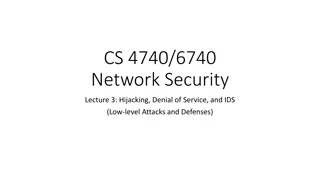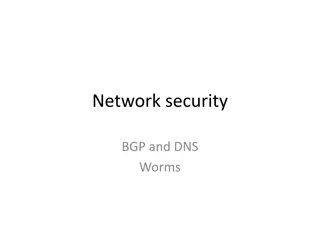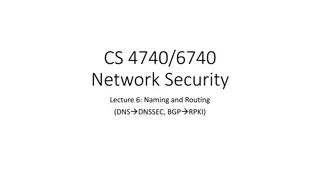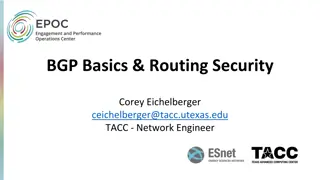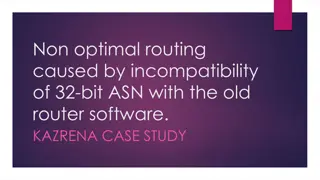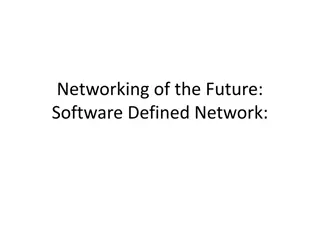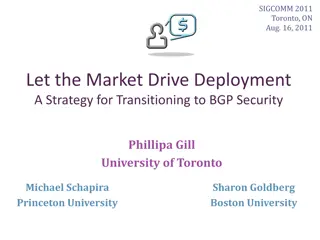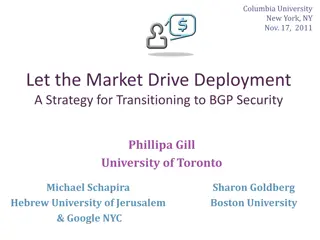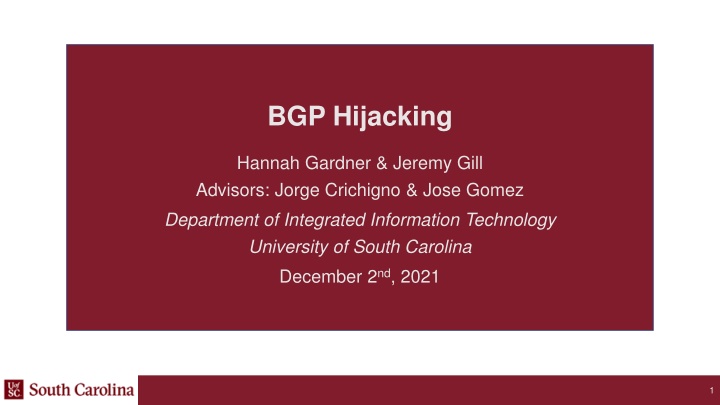
BGP Hijacking in Autonomous Systems
Learn about BGP hijacking, a malicious practice where routers impersonate legitimate ones to reroute Internet traffic. Discover the importance of BGP authentication in preventing such attacks and securing network stability.
Download Presentation

Please find below an Image/Link to download the presentation.
The content on the website is provided AS IS for your information and personal use only. It may not be sold, licensed, or shared on other websites without obtaining consent from the author. If you encounter any issues during the download, it is possible that the publisher has removed the file from their server.
You are allowed to download the files provided on this website for personal or commercial use, subject to the condition that they are used lawfully. All files are the property of their respective owners.
The content on the website is provided AS IS for your information and personal use only. It may not be sold, licensed, or shared on other websites without obtaining consent from the author.
E N D
Presentation Transcript
BGP Hijacking Hannah Gardner & Jeremy Gill Advisors: Jorge Crichigno & Jose Gomez Department of Integrated Information Technology University of South Carolina December 2nd, 2021 1
Agenda Introduction Background Information Problem Description Proposed Solution Conclusion 2
Introduction The Internet is a network of networks, or autonomous systems (AS). Border Gateway Protocol (BGP) allows autonomous systems to connect to other autonomous systems. BGP offers network stability because it can find alternative routes in cases of route failures. 3
Background Information BGP peers/neighbors are two routers which have established a connection to exchange routing information. BGP peers advertise networks to update each peer s routing table. Fig 1: Two autonomous systems, AS 100 and AS 200 communicate through external BGP (EBGP) 4
Background Information BGP hijacking occurs when malicious routers advertise networks that do not belong to them (i.e., impersonating legitimate routers). Consequently, the attacker can reroute Internet traffic. This traffic can be monitored or redirected, resulting in performance degradation. 5
Problem Description BGP routes can be hijacked when a malicious actor spoofs route information. In this scenario, there are 2 networks, LAN 1 and LAN 2. A malicious router that it is LAN 2, therefore redirecting traffic from LAN 1 to LAN 2 to itself. advertises Intended route Redirected route Fig. 2: Traffic is redirected from its intended recipient to a malicious actor via spoofing. moving 6
Proposed Solution BGP authentication adds a layer of security between trusted peers. BGP authentication uses the Message Digest 5 (MD5) cryptographic hash function to produce a signature that can only be reproduced by legitimate peers. 7
Proposed Solution The malicious router hijacks the route between the 100 network and the 200 network. By observing the routing table, we see that the 200 network s next-hop changes 203.0.113.3 to 203.0.113.10 from This means the router has hijacked the route! 8
Proposed Solution With BGP authentication, this is no longer possible. 9
Conclusion BGP is necessary for networks to connect and communicate with other networks. BGP authentication greatly reduces the vulnerability of threat actors posing as legitimate networks and stealing data. 10

